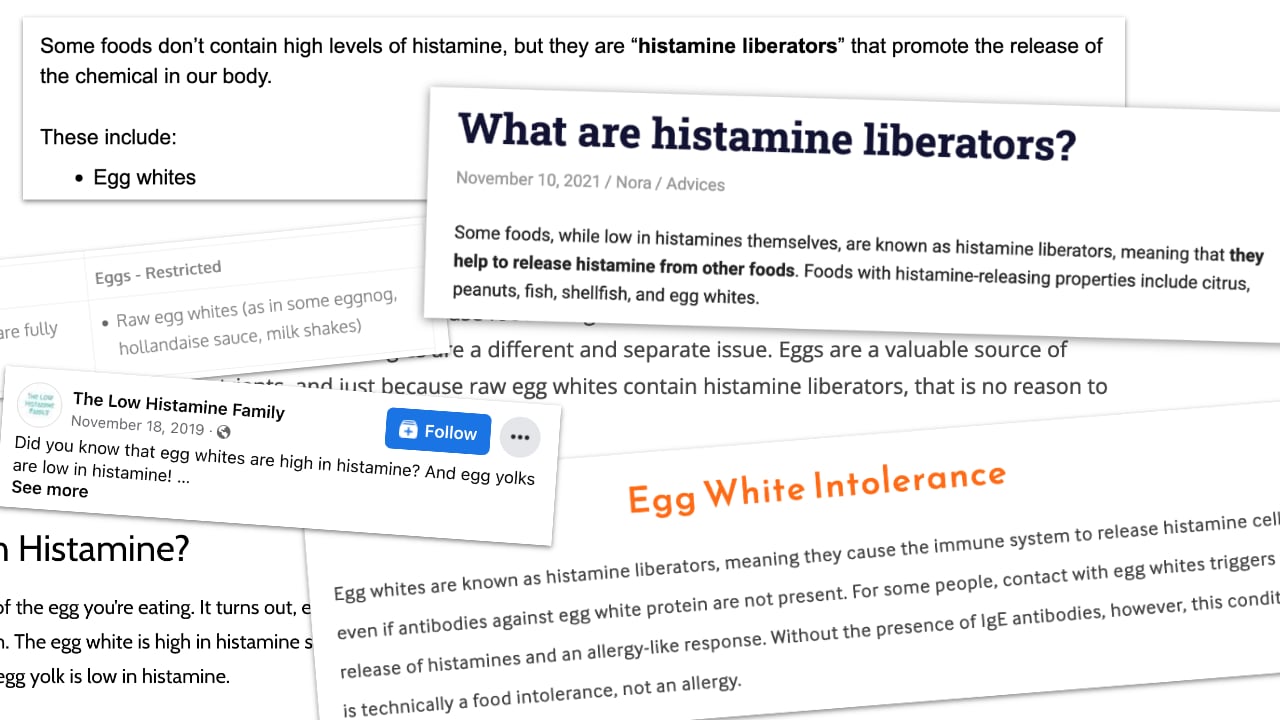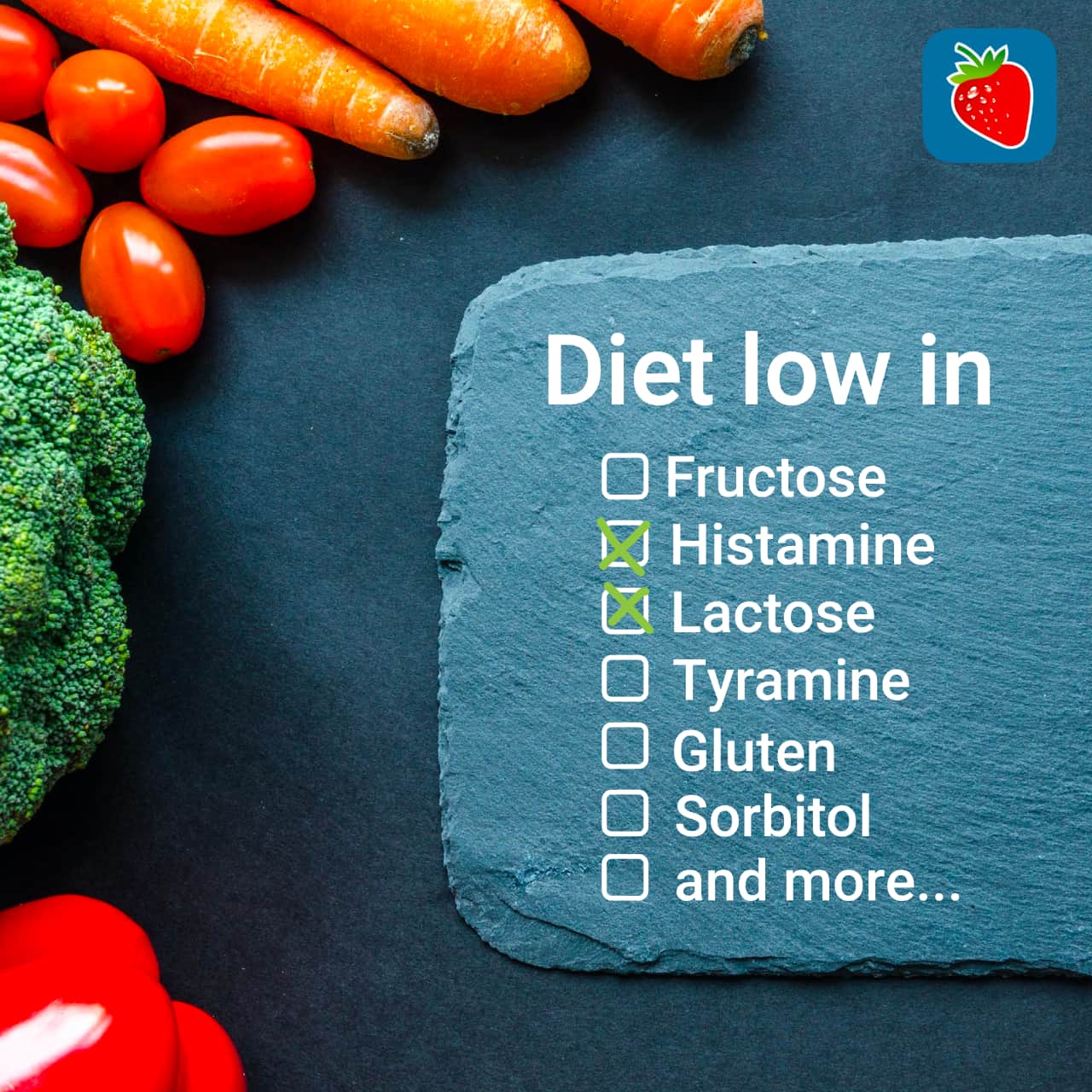Are eggs off-limits if you suffer from histamine intolerance?
04/26/2022 Food Intolerances
If you run a quick Google search for “histamine intolerance,” you will find list after list containing foods that may be eaten and those that may not. On the unsuitable foods list is egg white, which is classified as a histamine liberator. Egg yolk, on the other hand, is on the permitted list as it is considered to be tolerable. But take a closer look and you will notice that there is never an indication of the origin of this information. So where does the statement come from that says histamine intolerance sufferers should avoid eggs?

Eggs are an indispensable ingredient in many dishes and are not easily replaced by other foods. The average person in the United States consumes 286 eggs per year, and for many people, eggs are their primary source of omega-3 fatty acids. So any decision to remove them from our diet should be taken after careful consideration, since there may in fact be no compelling reason to do so.

▲ Figure 1: Information from various popular websites on histamine intolerance and eggs, which are considered to be high in histamine. Egg white is often classified as a histamine liberator.
Unfortunately, most statements found online about eggs contain no source information. This means we can neither verify what we are told is correct nor be sure which ingredient could be responsible for any potential histamine-releasing effect.
Let us return to the real question of whether egg white is a histamine liberator. In our research, we came across the original source on which the claim about egg white is predicated. Conducted in 1952, the study recorded how cats, rats, and dogs were intravenously injected with a solution containing either raw or cooked egg white. The injection caused histamine to be released in the cats and the rats.
The answer is no: we simply may not apply these results to humans for a number of reasons. Firstly, the method of administration (intravenous injection) is not comparable to the normal human consumption of eggs. Egg white is exposed to acids and digestive enzymes in the stomach and small intestine, and thus is broken down into single amino acids or chains of two to three amino acids. These small egg white particles can then pass through the intestinal mucosa and be absorbed into the blood. On the other hand, intravenous injection means all proteins, fats and other compounds enter the bloodstream directly and remain unchanged.
Those compounds that reach the blood via the normal digestive process are therefore not at all comparable to those that were injected intravenously in the 1952 trial.
And as we have established, the study was carried out on animals, not humans. We can see from the results that the histamine-releasing effect was not even transferrable to dogs, in whom no increase in histamine was observed; the cats responded to raw as well as cooked egg white; and while the rats only displayed a reaction to raw egg white. The inconsistent findings mean we can therefore make no definitive statement at all about a histamine-releasing effect of egg white (either raw or cooked). To be able to make such a claim, one would need to conduct a completely different experiment and run the tests on human subjects.
Alongside the claim that egg white has a histamine-releasing effect, we also encounter statements like "eggs are high in histamine”. Claims like this must be vigorously questioned.
There are several studies that examine the histamine content or the content of biogenic amines in eggs. None of them revealed substantial amounts of histamine, not even after an extended period of storage. In fact, eggs contain just a few biogenic amines, and this is actually not surprising, since eggs are not subjected to any microbial maturation process in which larger amounts of histamine may be formed.
The first lesson to be learned is that deriving broad nutritional recommendations from 70-year-old animal experiments and applying them to anyone that suffers from histamine intolerance is nonsensical and has no basis in fact. It bears repeating that a histamine-releasing effect of eggs has not been scientifically proven to date.
That does not mean, however, that nobody will have an intolerance to eggs. Changes in the permeability of the intestinal barrier resulting from an illness may be one way to explain why some people experience reactions when consuming eggs. Another reason may even be a genuine food allergy, which could be triggered by proteins from either the egg yolk or the egg white (this would also explain why someone may be able to eat one but not the other). The allergy can be limited to chicken eggs, or it could extend to eggs from other bird species such as turkey or quail.
Overall, only a small percentage of those affected cannot tolerate eggs. Unfortunately, there is no other choice than to find out for yourself. A detailed food diary can help to see if reproducible symptoms occur after eating eggs. Ideally, sufferers will also have a diagnostic confirmation from a specialist doctor.
The recommendations we make in our app reflect the latest research on this topic, with detailed notes that includes sources and citations. In addition to the histamine intolerance option, you can configure a profile for consuming eggs, with which you can color code all foods that contain eggs. This profile, and the many others available, allows you to flexibly customize the app according to your individual needs.
 Our price-winning "Food Intolerances" app helps you manage your diet. Available for iOS and Android. Check it out:
Our price-winning "Food Intolerances" app helps you manage your diet. Available for iOS and Android. Check it out:
Share article
Back to blog
Sources:
https://www.statista.com/statistics/183678/per-capita-consumption-of-eggs-in-the-us-since-2000/
M. Schachter et al., The release of histamine by egg-white in non-sensitized animals, J. Physiol. 118 (1952), 258–263
B. J. Vlieg-Boerstra et al., Mastocytosis and adverse reactions to biogenic amines and histamine-releasing foods: what is the evidence?, The Netherlands Journal of Medicine 63:7 (2005), 244–249
B. Ramos et al., Changes of yolk biogenic amine concentrations during storage of shell hen eggs, Food Chemistry 116 (2009), 340–344
Image:
Photo by Natalie Rhea on Unsplash

Eggs are an indispensable ingredient in many dishes and are not easily replaced by other foods. The average person in the United States consumes 286 eggs per year, and for many people, eggs are their primary source of omega-3 fatty acids. So any decision to remove them from our diet should be taken after careful consideration, since there may in fact be no compelling reason to do so.

▲ Figure 1: Information from various popular websites on histamine intolerance and eggs, which are considered to be high in histamine. Egg white is often classified as a histamine liberator.
Unfortunately, most statements found online about eggs contain no source information. This means we can neither verify what we are told is correct nor be sure which ingredient could be responsible for any potential histamine-releasing effect.
Is egg white really a histamine liberator?
Let us return to the real question of whether egg white is a histamine liberator. In our research, we came across the original source on which the claim about egg white is predicated. Conducted in 1952, the study recorded how cats, rats, and dogs were intravenously injected with a solution containing either raw or cooked egg white. The injection caused histamine to be released in the cats and the rats.
Are these results applicable to humans?
The answer is no: we simply may not apply these results to humans for a number of reasons. Firstly, the method of administration (intravenous injection) is not comparable to the normal human consumption of eggs. Egg white is exposed to acids and digestive enzymes in the stomach and small intestine, and thus is broken down into single amino acids or chains of two to three amino acids. These small egg white particles can then pass through the intestinal mucosa and be absorbed into the blood. On the other hand, intravenous injection means all proteins, fats and other compounds enter the bloodstream directly and remain unchanged.
Those compounds that reach the blood via the normal digestive process are therefore not at all comparable to those that were injected intravenously in the 1952 trial.
And as we have established, the study was carried out on animals, not humans. We can see from the results that the histamine-releasing effect was not even transferrable to dogs, in whom no increase in histamine was observed; the cats responded to raw as well as cooked egg white; and while the rats only displayed a reaction to raw egg white. The inconsistent findings mean we can therefore make no definitive statement at all about a histamine-releasing effect of egg white (either raw or cooked). To be able to make such a claim, one would need to conduct a completely different experiment and run the tests on human subjects.
What about the histamine content of eggs?
Alongside the claim that egg white has a histamine-releasing effect, we also encounter statements like "eggs are high in histamine”. Claims like this must be vigorously questioned.
There are several studies that examine the histamine content or the content of biogenic amines in eggs. None of them revealed substantial amounts of histamine, not even after an extended period of storage. In fact, eggs contain just a few biogenic amines, and this is actually not surprising, since eggs are not subjected to any microbial maturation process in which larger amounts of histamine may be formed.
What conclusions can we draw then?
The first lesson to be learned is that deriving broad nutritional recommendations from 70-year-old animal experiments and applying them to anyone that suffers from histamine intolerance is nonsensical and has no basis in fact. It bears repeating that a histamine-releasing effect of eggs has not been scientifically proven to date.
That does not mean, however, that nobody will have an intolerance to eggs. Changes in the permeability of the intestinal barrier resulting from an illness may be one way to explain why some people experience reactions when consuming eggs. Another reason may even be a genuine food allergy, which could be triggered by proteins from either the egg yolk or the egg white (this would also explain why someone may be able to eat one but not the other). The allergy can be limited to chicken eggs, or it could extend to eggs from other bird species such as turkey or quail.
Overall, only a small percentage of those affected cannot tolerate eggs. Unfortunately, there is no other choice than to find out for yourself. A detailed food diary can help to see if reproducible symptoms occur after eating eggs. Ideally, sufferers will also have a diagnostic confirmation from a specialist doctor.
Remember: With such a complex topic, we should always look critically at any piece of information that does not provide a source. This is often a sign that what we are reading has been copied from elsewhere without being verified. Put plainly, eggs should only be removed from our diet if they cause reproducible symptoms. Otherwise, we will be denying ourself an important source of nutrition, perhaps unnecessarily, as many sufferers of histamine intolerance indeed do.
How can the Food Intolerances app help with histamine intolerance?
The recommendations we make in our app reflect the latest research on this topic, with detailed notes that includes sources and citations. In addition to the histamine intolerance option, you can configure a profile for consuming eggs, with which you can color code all foods that contain eggs. This profile, and the many others available, allows you to flexibly customize the app according to your individual needs.
 Our price-winning "Food Intolerances" app helps you manage your diet. Available for iOS and Android. Check it out:
Our price-winning "Food Intolerances" app helps you manage your diet. Available for iOS and Android. Check it out:Share article
Back to blog
Sources:
https://www.statista.com/statistics/183678/per-capita-consumption-of-eggs-in-the-us-since-2000/
M. Schachter et al., The release of histamine by egg-white in non-sensitized animals, J. Physiol. 118 (1952), 258–263
B. J. Vlieg-Boerstra et al., Mastocytosis and adverse reactions to biogenic amines and histamine-releasing foods: what is the evidence?, The Netherlands Journal of Medicine 63:7 (2005), 244–249
B. Ramos et al., Changes of yolk biogenic amine concentrations during storage of shell hen eggs, Food Chemistry 116 (2009), 340–344
Image:
Photo by Natalie Rhea on Unsplash
![[Blog]](../../rw_common/images/baliza_logo_retina.png)

